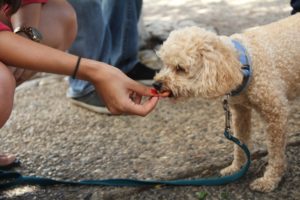
7 Things You Do That Hurt Your Dog – And Have to Stop!
As an owner, you wouldn’t do anything to hurt your dog intentionally. You take him for long walks, buy better-quality food, and ensure he gets more than enough cuddles. When you accidentally step on his tail you almost cry yourself! But there are things that we do for our dogs that actually hurt them – and we need to stop. Although we would never purposefully harm our dogs, some of our actions can result in weight-gain, attitude problems, or health related issues. We are unaware of the impact small things have (like letting your dog jump on you when you get home) that can be bad for your dog’s wellbeing. Here are the 7 things we need to stop doing for the benefit of our dogs.
Feeding Them Our Food

There is something novel about sharing a piece of your steak or buying your dog that famous Starbucks Puppacino. The problem is that dogs are not able to digest human food the same way we can. Dogs need a specific diet filled with certain nutrients and vitamins to keep her healthy and happy. Some human foods are safe and even good for your dog’s health, but too often we give unhealthy treats that can hurt your dog. Ice cream, seasoned foods, and other items she would not normally eat can disrupt her diet and lead to weight gain. When a dog gains weight, it affects them in other ways as well, such as heart problems or joint pain. Consider carefully what foods you give your dog so that you can protect her in the future.
Unknowingly Encouraging Separation Anxiety

One of the things owners unknowingly do is create separation anxiety in their dogs. It can easily develop without you even knowing, as your dog becomes reliant on your presence. Small things like getting excited after a period of absence, or getting emotional when you leave will increase the likelihood of separation anxiety. These emotional reactions are what your dog will recognize and it could reinforce the feelings of anxiety. Your dog eventually will learn that when you leave him, it is a bad thing. Each time that you leave the house or room, that anxiety will be instant, as it is now a reinforced behaviour. Avoid reinforcing separation anxiety that can hurt your dog, and reduce this negative response. Playing games that include you running away from them can also increase separation anxiety as he is rewarded for chasing and finding you.
BONUS TIP: If your dog already experiences anxiety, there are ways to reduce it and help him become comfortable being alone. Take action to reduce his stress by changing your approach when you see him (either leaving or greeting). Avoid saying too much when you leave the house. A simple “be a good boy” is fine, but prevent yourself from giving too many hugs and comforting words when you leave. Another way to reduce separation anxiety is to wait until he is settled before you greet him. This is very difficult, as there is nothing happier than a wagging tail and big smile when you come home. But as hard as it will be, let your dog settle down while you enter the house, then once you are ready, greet him calmly. When you stop encouraging separation anxiety behaviours, it is for your dog’s benefit.
Letting Them Run the House

As a puppy, rules are clearly set and boundaries are made. But over time, we begin to relax a little when we know he will no longer eat the couch or grab food off the counter. This relaxation then starts giving your dog permission to do more. Soon enough, your dog has begun to make demands and gets away with things that would not have been acceptable when he was learning. As owners, we need to stop letting our dogs run the show and instead keep those boundaries. If you originally did not want your dog sitting on the couch, and after a while he began hopping up – re-teach that boundary. It can hurt your dog to have lax rules – so make sure he knows his place in the household. If your dog thinks he controls the “pack” (you), then he will continue to push until he gets what he wants and ignore you when he feels like it (which can be extremely dangerous as he chases a bunny across the street).
Is your dog past the point of simple training? Every dog can be taught a new trick no matter what age! Begin training again, starting at square one to make him aware that the behaviour he is exhibiting is not allowed.
Poor Nail Trims

If you are confident enough to cut your dog’s nails, good on you! It is often a task too daunting for many and is left to the professionals. For those who do venture to cut nails, one thing to stop doing is cutting them badly! Nails are usually too short or not short enough. If nails are cut too short, your dog will yelp as the quick (a blood vessel and nerve found in the nail) has been clipped, resulting in a lot of blood. Usually she will quickly recover once the bleeding has stopped (some home treatments use cornstarch) but it does hurt your dog. In some cases, though, the quick can get infected – something to watch for. On the flip side, it is the fear of hitting the quick that prevents us from cutting their nails short enough. If nails are too long after a trimming, they get in the way of your dog’s walking and can lead to pain. Instead of walking on their pads like they normally do, they end up balancing on their nails. This is not only bad for her posture but can lead to joint pain. If you are not comfortable trimming your dog’s nails, be sure to book consistent appointments to keep your dog’s nails well-groomed!
Height of Food Dishes

Surprisingly, one thing owners never think of is the height of their dog’s food dishes. Most owners keep the dishes on the ground where mess can be easily cleaned up. But when food dishes are left on the floor, big dogs are forced to lean over farther and balance to eat their food, which can hurt your dog. It is painful for your dog’s joints and puts pressure on his front paws when he leans down to reach the food. If not attended to early on, joint pain can be a result, making movements more difficult in his old age. Some large dogs can even experience ‘bloat’, a dangerous gastric issue. Simply raise the food dishes up with a box or step stool. Get those dishes off the floor!
Too Much or Too Little Exercise

As our dogs grow up and become well trained, we are able to do more with them. We can go for long hikes, play ball in a field, and even start training for a marathon together. Because your dog is older it is important to be aware of how much exercise you are giving him. If you walk him every day for several hours, your dog is probably getting too much exercise. There are some breeds that need this constant exercise, but for older dogs, they are better off resting or going on shorter excursions more often. Pushing your dog too hard or exercising in the extreme heat can be taxing on your dog’s body. On the other hand, there are instances when a dog does not get enough exercise. This can be due to the busy schedule of the owner who has little time to take the dog out. If your dog is not getting enough exercise, it can cause him to act out (chewing, digging, etc.) or worse, gain weight. When dog’s gain weight, the extra pounds put stress on his legs and joints and it can lead to joint pain that hurts your dog. Find that perfect balance. Once you have found that ideal amount, your dog will be happy and healthy!
Leaving Them in the Car

Although in the past it seemed alright to leave your dog in the car while you quickly ran an errand, it is not anymore (and wasn’t then either). No matter how long you can last in the car in the heat, dogs handle heat differently. For a dog, being left in a vehicle for even a few minutes can be similar to being left in a heated box for twice as long. While humans sweat to cool off, dogs cannot. Instead, dogs sweat through their paws and pant to try and keep cool. But with a heavy coat of fur and intense confined heat, staying in a car can quickly hurt your dog. When a dog is left in the car too long it has lasting effects on her health and can even cause death. Cracking a window or parking in the shade won’t help if the car is still sitting outside in the heat of summer (no, not even with all 4 windows cracked and you gone for “just a minute”). Do your dog the biggest favour of her life and leave her at home when you run errands. Follow this rule of thumb: If you are not in the car, she is not in the car.
We feel deeply for our pets, and would never want to do anything to harm them. That is why it is important to be aware of what we give them and do with them. When we are aware what hurts our dogs, we can take action to avoid it. Stop doing these 7 things and your dog will thank you when they are old and grey and still able to run and play!
